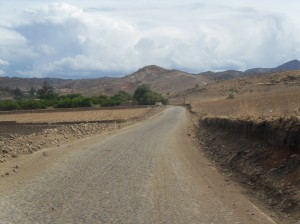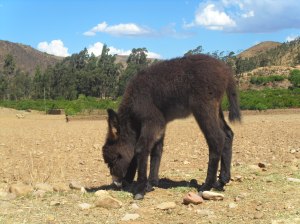Discovering Morado K’asa
- Posted In : morado-kasa , Stories
- 0 : comment
Every week, I find myself walking 2k to the nearest town, Cororo, to buy a bus ticket back to Sucre. Normally my walk takes me along the Tarabuco carretera, a 30 minute journey traipsing across a beautiful but incredibly dry landscape. However, the highway twists and turns, causing the trip to meander rather than lead directly to the neighboring town. Having walked the same road a couple of times, I was convinced that there must be a more direct route between the two. Today, I decided that I would try to find the illusive shortcut between my home in Morado K’asa and Cororo.
I made my way out of Morado K’asa along the highway, as usual. The scenery is breathtaking. Rolling hills covered in scrub stretch to the horizon, and oft-dry riverbeds slice through the cracked and crumbling earth. Birds are chirping, and the wind creates a dull roar as it rushes past my ears. A few farmers are out, plowing their fields; a new planting season has begun. Arriving at Cororo marks a drastic change in scenery. Unlike Morado, the town and surrounding area is well irrigated. The fields are green with young maíz, and tall trees dot the small but efficiently-managed creek that runs through town. After waiting 45 minutes for the bus worker to arrive and open shop, I successfully purchased my return ticket. Buying a ticket in advance is essential. If not, you will find yourself standing in the aisle of the bus, sandwiched between two large indigenous women, for the 3 hour trip back to Sucre. This, however, is another blog post entirely.
Ticket now secure, my real adventure was just beginning. I headed out of Cororo the same way I came, but turned onto a dirt path that I had scouted on a previous trip. It looked promising. I followed the path down a small hill, which ran alongside an unused irrigation gulley. The path ended, but I scrambled down a set of rocks until my progress was stopped by a barricade marking the edge of a farmer´s field. Unwilling to retrace my steps, I clamored over the barrier and tip-toed through the field of ankle-high plants. I skirted along the side of another field, where I ended up at the edge of an insurmountable cliff. A dead end! The ground below was about a 25 ft. drop, and the other side of the ravine was a sound 60 ft. across. About 10 feet from where I stood, I noticed a rickety, hand-made ladder that descended down into the creek bed. No way was I going on that! And besides, once down there, what would I have done? There didn’t appear to be a way to get back up on the other side.
At that moment, three kids that I recognized from the Morado K’asa library appeared around the bend of the creek bed. They were Isabella, Carolina, and little Pablito. I shouted to them, and they were clearly surprised to see me overheard. Obviously I was off the beaten path and a bit lost, and they laughed at me when I told them I was trying to find my way back to Morado. They said I could follow them, but that the only way down was the highly questionable ladder. I gathered my nerves and slowly made my way down to join the three of them.
The environment down in the ravine was amazing. Tall trees stood along the edges of the cliff, their roots stretching all the way down to the tiny creek that trickled through the deep ravine. We followed the creek downstream, all the while shadowed by the sheer cliff sides that were covered in exotic plants, small trees and flowers. We came to an opening where the creek bed spread its fingers across a flat plain. The kids started lapping up the water, against my best efforts to tell them otherwise. They rattled off a bunch of reasons why the water was indeed safe for us to drink, none of which made any sense. They pulled some algae out of the stream, and told me that it was quite tasty when fried. Pablito proceeded to shove some in his mouth.
We slowly made our way back to Morado K’asa, taking a few more water breaks along the way. About 10 minutes out of Morado, the kids said there was something that I must see. A place to swim, they told me, in this arid landscape. We took a detour away from the direction of town, which followed the stream around an outcrop of red, jagged bedrock. When we turned the corner, I could hardly believe my eyes. There, tucked away in the recesses of red rock and rolling hills, was an oasis of sorts. A few kids were splashing around in a watering hole created by the tiny creek. A donkey and a flock of sheep stood on the bank, drinking and reveling in the water’s freshness. The water that overflowed the pool ran over the side of a small cliff and continued its journey downstream. By the side of the pool stood a single, yet perfect shade tree, and over the cliff the trees gathered in numbers to create a wonderfully shady and cool environment. I looked at my watch. It had been an hour and a half since I left Cororo. Apparently I hadn’t found the shortcut that I was envisioning. But in my wandering, I stumbled across something even better. I had found paraíso, paradise.
– Rob









